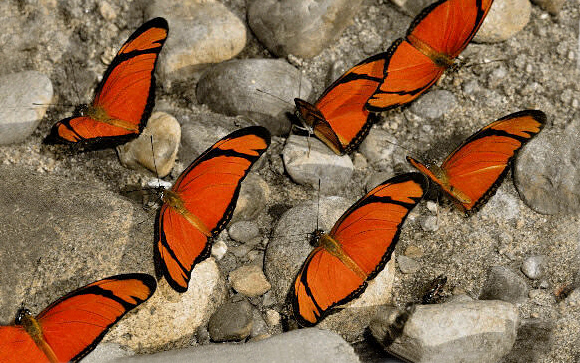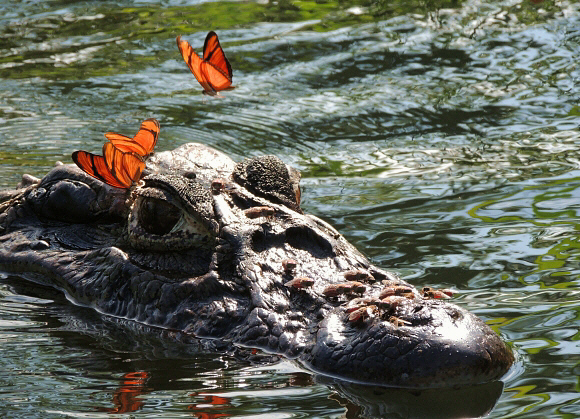 Dryas iulia, Rio Pindayo, Peru – Adrian Hoskins
Dryas iulia, Rio Pindayo, Peru – Adrian Hoskins
Introduction
The Heliconiinae is divided into 3 tribes Acraeini, Argynnini and Heliconiini. The latter are colloquially known as Longwings and are confined to the neotropical region. They are easily recognised by their distinctive patterns, elongated forewings and characteristic delicate fluttering flight.
The subtribe Heliconiini includes Heliconius ( 39 species ), and the smaller genera Dryas, Podotricha, Philaethria, Laparus, Eueides, Neruda, Agraulis, Dione and Dryadula.
The dazzling orange Dryas iulia is widespread and common in the southern United States, Central America and much of the Caribbean, and occurs throughout all of the tropical and subtropical areas of South America.
 Dryas iulia, Rio Madre de Dios, Peru – Adrian Hoskins
Dryas iulia, Rio Madre de Dios, Peru – Adrian Hoskins
Mud-puddling
In tropical regions males of many species visit sandbanks, riversides and damp paths to indulge in ‘mud-puddling’, i.e. visiting patches of damp ground where they filter-feed by continually pumping water through their bodies while extracting dissolved minerals. The filtered water is often squirted back onto the ground to dissolve further minerals which are reimbibed. These chemicals are passed to females via spermatophore during copulation. Males which have already mated usually return to replenish their salts, and afterwards often mate again with another female. Females don’t normally mud-puddle – they feed instead on nectar, visiting herbaceous plants and flowering trees.
On the sandbanks, initially just one male will chance upon a suitable feeding spot, but other males flying past seem able to recognise their brethren on the ground, and swoop down to join them. The bright patch of colourful butterflies quickly becomes a magnet to every passing male of the same species, and after an hour or so hundreds or even thousands of butterflies may assemble at certain particularly mineral-rich sandbanks.
Normally several different species are present at these feeding places. It might be expected that the various species would be randomly distributed on the ground but this is not the case. Each butterfly polarises very strongly towards it’s own brethren, so that each species congregates as a discrete group. In calm weather the butterflies in each group are positioned randomly, but on river beaches there is usually a constant gentle breeze, so all the butterflies tend to face into the breeze. In this way they are less likely to be blown about and lose their feeding spot to a competitor.
Habitats
The butterflies fly in rainforest and deciduous forests, but are commonly encountered in disturbed open habitats such as forest clearings, cattle pastures, along riverbanks, and in flowery gardens.
 Dryas iulia, Catarata Bayoz, Peru – Adrian Hoskins
Dryas iulia, Catarata Bayoz, Peru – Adrian Hoskins
Lifecycle
Like most other Heliconiines, the Julia lays it’s eggs on Passiflora ( Passion flower ). There has been a great deal of study into the relationship between these plants and Heliconiine butterflies, which strongly suggests they they co-evolved. There is a constant evolutionary battle in which the plants try to defend themselves from the butterflies. Some Passiflora vines for example produce false stipules at the base of leaf stems, that induce egg laying by certain Heliconiine species. A day or two later the stipules drop off, carrying the eggs with them. Eggs which fall to the ground probably get eaten by ants, but even if they survive, the resulting larvae will starve. Certain other Passiflora vines produce tiny tubercules on the stipules that mimic Heliconiine eggs. Any butterfly visiting the plant sees the false eggs, is misled into thinking that the plant is already overladen with eggs, and is consequently inhibited from ovipositing.
The body of the multicoloured caterpillar is adorned with long black thorny spines, with a further pair arising from the head. It feeds openly in the daylight.
Adult behaviour
Males often gather in small groups to drink at damp mineral-rich sites such as salt-licks, sandbanks, peccary wallows, or urine-soaked earth. They are also regularly observed sipping liquid from the corner of the eyes of the yellow-throated caiman in Brazil, or from the eyes of turtles in Peru!

Dryas iulia, Brazil – Miguel Antonio-Silva-Stefanelli
Females behave differently, visiting flowers including Lantana, Eupatorium and various canopy species, but as well as drinking nectar they feed on dissolved pollen, from which they obtain nutrients that have been shown to be essential to egg production.
I have not observed the courtship, but in Costa Rica have found mated pairs resting on low foliage with wings closed, in early afternoon. When copulated the butterflies are very reluctant to fly.

Dryas iulia, Catarata Bayoz, La Merced, Peru – Adrian Hoskins
